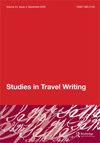旅行写作部落:寻找流派的旅程
Q2 Arts and Humanities
引用次数: 2
摘要
《旅行写作部落:寻找一种类型的旅程》既是一本关于(主要是)英国旅行写作的专著,也是一本旅行书。在这本书中,作者、叙述者和主角蒂姆·汉尼根(Tim Hannigan)游历了不同的地方,采访了13位旅行作家、一位旅行写作学者(卡尔·汤普森)、一位旅行书籍出版商(巴纳比·罗杰森)和一群旅行写作读者;他去参加旅行写作学术会议(在柏林),在图书馆(在伊顿、彭赞斯、莱斯特和爱丁堡)和一座大教堂(在圣奥尔本斯)寻找关于旅行写作类型起源和发展的文本和非文本证据。二百九十五年前,乔纳森·斯威夫特(匿名)出版了一本书,书中他用当时被称为“航海与旅行”的形式,讽刺了英国社会和旅行作家的各个方面。蒂姆·汉尼根用旅行书的形式,对旅行写作的本质、过去和未来,以及旅行写作研究的学术学科,提出了最相关的问题。在他的书的第二章中,Hannigan宣称“我需要的是一个定义”(17),并讨论了四位以英语为母语的旅行写作学者(Fussell, Raban, Thompson和Youngs)对这一类型的定义,最终接受了Jan Borm的定义:本文章由计算机程序翻译,如有差异,请以英文原文为准。
The Travel Writing Tribe: Journeys in Search of a Genre
The Travel Writing Tribe: Journeys in Search of a Genre is both a monograph on (mostly) British travel writing and a travel book in which Tim Hannigan, its author, narrator and principal character, travels to various locations to interview 13 travel writers, one travel writing scholar (Carl Thompson), one publisher of travel books (Barnaby Rogerson), and a group of travel writing readers; he journeys to a travel writing academic conference (in Berlin) and to search, in libraries (in Eton, Penzance, Leicester and Edinburgh) and in one cathedral (in St Albans), for textual and non-textual evidence of the origins and developments of the genre of travel writing. Two hundred and ninety-five years after Jonathan Swift (anonymously) published a book in which he used the format of what was then known as “voyages and travels” to create a satire on various aspects of British society and its travel writers, Tim Hannigan uses the travel book format to voice the most pertinent questions about the nature, the past and the future of both travel writing and the academic discipline of travel writing studies. In Chapter Two of his book Hannigan declares “What I needed was a definition” (17), and having discussed the definitions of the genre provided by four Anglophone travel writing scholars (Fussell, Raban, Thompson and Youngs), settles for the definition by Jan Borm:
求助全文
通过发布文献求助,成功后即可免费获取论文全文。
去求助
来源期刊

Studies in Travel Writing
Arts and Humanities-Literature and Literary Theory
CiteScore
0.40
自引率
0.00%
发文量
13
期刊介绍:
Founded in 1997 by Tim Youngs, Studies in Travel Writing is an international, refereed journal dedicated to research on travel texts and to scholarly approaches to them. Unrestricted by period or region of study, the journal allows for specific contexts of travel writing to be established and for the application of a range of scholarly and critical approaches. It welcomes contributions from within, between or across academic disciplines; from senior scholars and from those at the start of their careers. It also publishes original interviews with travel writers, special themed issues, and book reviews.
 求助内容:
求助内容: 应助结果提醒方式:
应助结果提醒方式:


